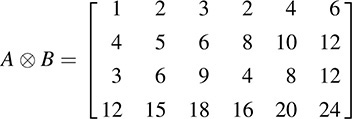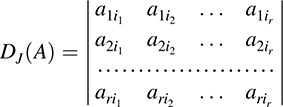Multilinear Products
A.1 Introduction
The material in this appendix is much more abstract than that which has previously appeared. Accordingly, many of the proofs will be omitted. Also, we motivate the material with the following observation.
Let S be a basis of a vector space V. Theorem 5.2 may be restated as follows.
THEOREM 5.2: Let g : S → V be the inclusion map of the basis S into V. Then, for any vector space U and any mapping f : S → U; there exists a unique linear mapping f* :V → U such that f = f* · g.
Another way to state the fact that f = f* · g is that the diagram in Fig. A-1(a) commutes.

A.2 Bilinear Mapping and Tensor Products
Let U, V, W be vector spaces over a field K. Consider a map
f : V × W → U
Then f is said to be bilinear if, for each ν ∈ V; the map fv : W → U defined by fv (w) = f(ν, w) is linear; and, for each w ∈ W; the map fw : V → U defined by fw (v) = f (ν, w) is linear.
That is, f is linear in each of its two variables. Note that f is similar to a bilinear form except that the values of the map f are in a vector space U rather than the field K.
DEFINITION A.1: Let V and W be vector spaces over the same field K. The tensor product of V and W is a vector space T over K together with a bilinear map g : V W → T; denoted by g (v, w) = ν ⊗ w; with the following property: (*) For any vector space U over K and any bilinear map f : V × W → U there exists a unique linear map f– : T → U such that f– g = f.
The tensor product (T, g) [or simply T when g is understood] of V and W is denoted by V ⊗ W; and the element ν ⊗ w is called the tensor of ν and w.
Another way to state condition (*) is that the diagram in Fig. A-1(b) commutes. The fact that such a unique linear map f* exists is called the “Universal Mapping Principle” (UMP). As illustrated in Fig. A-1(b), condition (*) also says that any bilinear map f : V × W → U “factors through” the tensor product T = V ⊗ W: The uniqueness in (*) implies that the image of g spans T; that is, span (ν ⊗ w) = T.
THEOREM A.1: (Uniqueness of Tensor Products) Let (T, g) and (T′; g′) be tensor products of V and W. Then there exists a unique isomorphism h:T → T′ such that hg = g′.
Proof. Because T is a tensor product, and g′ :V W → T′ is bilinear, there exists a unique linear map h :T → T′ such that hg = g′: Similarly, because T′ is a tensor product, and g′ : V ⊗ W → T′ is bilinear, there exists a unique linear map h′ :T′ → T such that h′g0 = g: Using hg = g′, we get h′hg = g: Also, because T is a tensor product, and g : V ⊗ W → T is bilinear, there exists a unique linear map h– : T → T such that h–g = g: But 1T} = g: Thus, h′h = h– = 1T. Similarly, hh0 = 1T′: Therefore, h is an isomorphism from T to T′:
THEOREM A.2: (Existence of Tensor Product) The tensor product T = V ⊗ W of vector spaces V and W over K exists. Let {ν1, … ; νm} be a basis of V and let {w1, … ; wn} be a basis of W. Then the mn vectors

form a basis of T. Thus, dim T = mn = (dim V) dim (W):
Outline of Proof. Suppose {ν1; … ; νm} is a basis of V, and suppose { w1, … ; wn } is a basis of W. Consider the mn symbols {tiji = i; … ; m; j = 1; … ; n}. Let T be the vector space generated by the tij. That is, T consists of all linear combinations of the tij with coefficients in K. [See Problem 4.137.]
Let ν ∈ V and w ∈ W. Say

Let g: V × W → T be defined by

Then g is bilinear. [Proof left to reader.]
Now let f : V × W → U be bilinear. Because the tij form a basis of T, Theorem 5.2 (stated above) tells us that there exists a unique linear map f* :T → U such that f– tij. Then, for  and
and  we have
we have

Therefore, f = f*g where f* is the required map in Definition A.1. Thus, T is a tensor product.
Let  be any basis of V and
be any basis of V and  be any basis of W.
be any basis of W.
Let ν ∈ V and w ∈ W and say

Then

Thus, the elements  span T. There are mn such elements. They cannot be linearly dependent because {tij} is a basis of T, and hence, dim T = mn. Thus, the
span T. There are mn such elements. They cannot be linearly dependent because {tij} is a basis of T, and hence, dim T = mn. Thus, the  form a basis of T.
form a basis of T.
Next we give two concrete examples of tensor products.
EXAMPLE A.1 Let V be the vector space of polynomials Pr–1 (x) and let W be the vector space of polynomials Ps–1(y). Thus, the following from bases of V and W, respectively,

In particular, dim V = r and dim W = s: Let T be the vector space of polynomials in variables x and y with basis

Then T is the tensor product V W under the mapping

For example, suppose ν = 2 ∈ 5x + 3x3 and w = 7y + 4y2. Then

Let V be the vector space of m × n matrices over a field K and let W be the vector space of p × q matrices over K. Suppose A = [a11] belongs to V, and B belongs to W. Let T be the vector space of mp × nq matrices over K. Then T is the tensor product of V and W where A ⊗ B is the block matrix

For example, suppose  and
and  . Then
. Then

Isomorphisms of Tensor Products
First we note that tensoring is associative in a cannonical way. Namely,
THEOREM A.3: Let U, V, W be vector spaces over a field K. Then there exists a unique isomorphism

such that, for every u ∈ U; v ∈ V; w ∈ W,

Accordingly, we may omit parenthesis when tensoring any number of factors. Specifically, given vectors spaces V1, V2, … ; Vm over a field K, we may unambiguously form their tensor product
V1 ⊗ V2 ⊗ … ⊗ Vm
and, for vectors νj in Vj, we may unambiguously form the tensor product
v1 ⊗ v2 ⊗ … ⊗ vm
Moreover, given a vector space V over K, we may unambiguously define the following tensor product:
rV = V V … V (r factors)
Also, there is a canonical isomorphism
(⊗rV) ⊗ (⊗ sV) → r+sV
Furthermore, viewing K as a vector space over itself, we have the canonical isomorphism
K ⊗ V → V
where we define a ⊗ v = av:
A.3 Alternating Multilinear Maps
Let f : Vr → U where V and U are vector spaces over K. [Recall Vr = V × V × … × V, r factors.]
(1) The mapping f is said to be multilinear or r-linear if f (v1, … ; vr) is linear as a function of each vj when the other vi’s are held fixed. That is,

where only the jth position changes.
(2) The mapping f is said to be alternating if

One can easily show (Prove!) that if f is an alternating multilinear mapping on Vr, then

That is, if two of the vectors are interchanged, then the associated value changes sign.
The determinant function D: M → K on the space M of n n matrices may be viewed as an n-variable function

defined on the rows R1, R2, … ; Rn of A. Recall (Chapter 8) that, in this context, D is both n-linear and alternating.
We now need some additional notation. Let K = k1, k2, … ; kr denote an r-list (r-tuple) of elements from (In = 1; 2; … ; n). We will then use the following notation where the vk’s denote vectors and the aik’s denote scalars:

Note νK is a list of r vectors, and aK is a product of r scalars.
Now suppose the elements in K = k1, k2, … ; kr ½ are distinct. Then K is a permutation sK of an r-list J = [i1, i2, … ; ir] in standard form, that is, where i1 < i2 < … < ir. The number of such standard-form r-lists J from In is the binomial coefficient:

[Recall sign (σK) = (–1)mK where mK is the number of interchanges that transforms K into J.]
Now suppose A = aij is an r × n matrix. For a given ordered r-list J, we define

That is, DJ (A) is the determinant of the r × r submatrix of A whose column subscripts belong to J.
Our main theorem below uses the following “shuffling” lemma.
LEMMA A.4 Let V and U be vector spaces over K, and let f : Vr → U be an alternating r-linear mapping. Let ν1, ν2, … ; νn be vectors in V and let A = aij be an r × n matrix over K where r ≥ n. For i = 1; 2; … ; r, let


where the sum is over all standard-form r-lists J = {i1, i2, … ; ir}.
The proof is technical but straightforward. The linearity of f gives us the sum

where the sum is over all r-lists K from {1; … ; n}. The alternating property of f tells us that f (vK) = 0 when K does not contain distinct integers. The proof now mainly uses the fact that as we interchange the vj’s to transform

so that i1 < … < ir, the associated sign of aK, will change in the same way as the sign of the corresponding permutation σK changes when it is transformed to the identity permutation using transpositions.
We illustrate the lemma below for r = ∈ and n = 3.
EXAMPLE A.4 Suppose f : V2 → U is an alternating multilinear function. Let ν1, ν2, ν3 ∈ V and let u; w 2 V. Suppose

Consider

Using multilinearity, we get nine terms:

(Note that J = [1; 2], J′ = [1; 3] and J″ = 2; 3 ½ are the three standard-form 2-lists of I = 1; 2; 3 ½.) The alternating property of f tells us that each f (vi, vi) = 0; hence, three of the above nine terms are equal to 0. The alternating property also tells us that f(vi, vf) = f (vf ; vr). Thus, three of the terms can be transformed so their subscripts form a standard-form 2-list by a single interchange. Finally we obtain

which is the content of Lemma A.4.
A.4 Exterior Products
The following definition applies.
DEFINITION A.2: Let V be an n-dimensionmal vector space over a field K, and let r be an integer such that 1 ≥ r ≥ n. The r-fold exterior product (or simply exterior product when r is understood) is a vector space E over K together with an alternating r-linear mapping g: Vr → E, denoted by g(v1, … ; vr) = v1 Λ … Λ vr, with the following property: (*) For any vector space U over K and any alternating r-linear map f : Vr → U there exists a unique linear map f* : E → U such that f* · g = f.
The r-fold tensor product (E, g) (or simply E when g is understood) of V is denoted by ΛrV, and the element ν1 Λ … Λ νr is called the exterior product or wedge product of the νi’s.
Another way to state condition (*) is that the diagram in Fig. A-1(c) commutes. Again, the fact that such a unique linear map f* exists is called the “Universal Mapping Principle (UMP)”. As illustrated in Fig. A-1 (c), condition (*) also says that any alternating r-linear map f : Vr → U “factors through” the exterior product E = Λr V. Again, the uniqueness in (*) implies that the image of g spans E; that is, span ν1 Λ … Λ vr ( ) = E.
THEOREM A.5: (Uniqueness of Exterior Products) Let (E, g) and E′; (g0) be r-fold exterior products of V. Then there exists a unique isomorphism h : E → E′ such that hg = g′.
The proof is the same as the proof of Theorem A.1, which uses the UMP.
THEOREM A.6: (Existence of Exterior Products) Let V be an n-dimensional vector space over K. Then the exterior product E = Λr V exists. If r > n, then E = {0}. If r ≥ n, then  . Moreover, if [ν1, … ; νn is a basis of V, then the vectors
. Moreover, if [ν1, … ; νn is a basis of V, then the vectors

where 1 ≥ i1 < i2 < …. < ir n, form a basis of E.
We give a concrete example of an exterior product.
Consider V = R3 with the usual basis (i, j, k). Let E = Λ2V. Note dim V = 3: Thus, dim E = 3 with basis i Λ j; i Λ k; j Λ k: We identify E with R3 under the correspondence

Let u and w be arbitrary vectors in V = R3, say

Then, as in Example A.3,

Using the above identification, we get

The reader may recognize that the above exterior product is precisely the well-known cross product in R3.
Our last theorem tells us that we are actually able to “multiply” exterior products, which allows us to form an “exterior algebra” that is illustrated below.
THEOREM A.7: Let V be a vector space over K. Let r and s be positive integers. Then there is a unique bilinear mapping

such that, for any vectors ui, wj in V,

EXAMPLE A.6 We form an exterior algebra A over a field K using noncommuting variables x, y, z. Because it is an exterior algebra, our variables satisfy:

Every element of A is a linear combination of the eight elements 1;

We multiply two “polynomials” in A using the usual distributive law, but now we also use the above conditions. For example,

Observe we use the fact that

